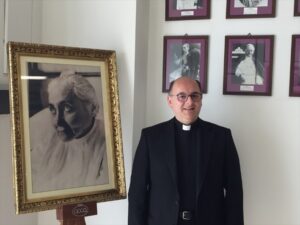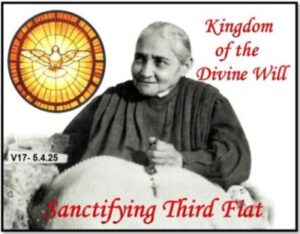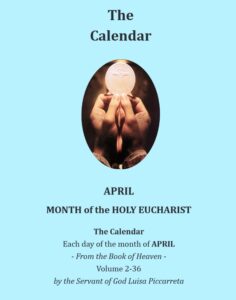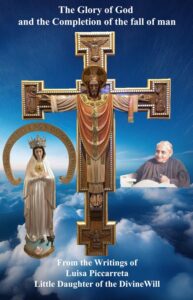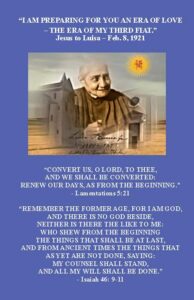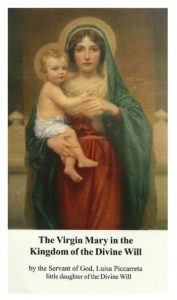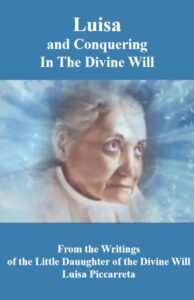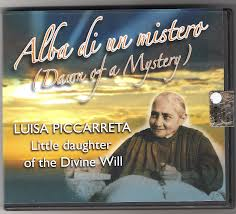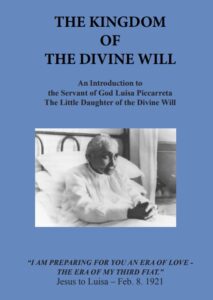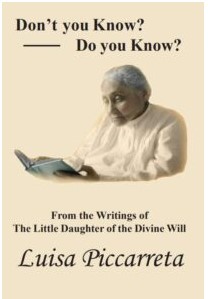Opening of the Cause of Beatification of Luisa Piccarreta – November 20, 1994
“Most dear ones, even now we are the sons of God, but that which we will be has not yet been revealed. We know then that when He will be manifested, we will be similar to Him because we will see Him as He is.” I John 3:2
On the Solemnity of Christ the King, 20 November, 1994 in the Mother church of Corato, Mons. Carmelo Cassati, Archbishop of Trani-Barletta-Bisceglie, having received the Non Obstare issued by the Congregation for the Causes of Saints, blessed the opening of the Cause of Beatification and Canonization of the Servant of God Luisa Piccarreta, secular third order Dominican. With the Archbishop himself as president of the Ecclesiastical Tribunal, joined by enthusiastic faithful from southern Italy and around the world, Luisa began her triumphal journey toward the Honors of the Altar.
On October 29, 2005, the conclusion of the Diocesan Phase of the Cause of Beatification and Canonization of the Servant of God, Luisa Piccarreta, was officially celebrated and transferred to the Vatican.
Closing of the Diocesan Phase
of the Cause of Beatification and Canonization
of the Servant of God, Luisa Piccarreta
October 29, 2005
Whoever has received particular graces attributed to the intercession of the Servant of God Luisa Piccarreta is requested to write to:
Postulation for the Cause of Beatification Luisa Piccarreta
Palazzo Arcivescoville
70059 Trani (BA) Italy
OR
If you prefer, go to the Official Site for the Beatification of the Servant of God Luisa Piccarreta, and submit your testimony online.
***
“For I reckon that the sufferings of this time are not worthy to be compared with the glory to come, that shall be revealed in us. For the expectation of the creature waiteth for the revelation of the sons of God. For the creature was made subject to vanity, not willingly, but by reason of him that made it subject, in hope: Because the creature also itself shall be delivered from the servitude of corruption, into the liberty of the glory of the children of God.”
Romans 8:18-21
***
Book of Heaven
V13 – 11/8/21 – Jesus says to Luisa: “Blessed are you, and all generations will call you Blessed”
. . . Afterwards, I was saying to my Jesus: ‘My Life, I enter into your Will to be able to extend myself in everyone and to everything – from the first to the last thought, from the first to the last word, from the first to the last action and step that were done, are done, and will be done. I want to seal everything with your Will, so that You may receive from everything the glory of your Sanctity, of your Love, of your Power; and so that all that is human may remain covered, hidden, marked by your Will. May nothing – nothing human remain, in which You do not receive Divine Glory.’
Now, while I was doing this and other things, my sweet Jesus came all festive, accompanied by innumerable Blessed, and said: “The whole of Creation says to Me: ‘My glory, my glory’.” And all the Saints answered: ‘Here, O Lord, we give You Divine Glory for everything.’ I could hear an echo from all sides, saying: ‘For everything we give You Love and Glory.’
And Jesus added: “Blessed are you (Luisa), and all generations will call you Blessed. My arm will make works of power in you. You will be the Divine reflection; and filling the whole earth, you will make Me receive from all generations that Glory which they deny to Me.” On hearing this, I remained confused, annihilated, and I did not want to write. And He, caressing me, told me: “No, no, you will do it – I want it. What I said will serve as honor of my Will. I Myself wanted to pay the just homage which befits the Sanctity of my Will; rather, I said nothing compared to what I could say.”
***
About the Congregation for the Causes of Saints
With the Constitution “Immensa Aeterni Dei” of January 22, 1588, Sixtus V created the Sacred Congregation of Rites and entrusted to it the task of regulating the exercise of divine worship and of dealing with the Causes of Saints. Paul VI, with the Apostolic Constitution “Sacra Rituum Congregatio” of May 8, 1969, divided the Congregation of Rites, creating two congregations: one for Divine Worship and another for the Causes of Saints. With the same Apostolic Constitution of 1969, the new Congregation for the Causes of Saints took on its own structure with three distinct offices: the judiciary, that of the Promoter General of the Faith, and the historical-juridical, which was the continuation of the Historical Section created by Pius XI on February 6, 1930. The Apostolic Constitution “Divinus Perfectionis Magister” of January 25, 1983, and the respective “Normae servandae in inquisitionibus ab episcopis faciendis in causis sanctorum” of February 7, 1983, made possible both a profound reform in procedure for canonization causes and the restructuring of the congregation. It was given a College of Relators, assigned to take care of the preparation of the “Positiones super vita et virtutibus (o super martyrio) of Servants of God.
John Paul II, with the Apostolic Constitution “Pastor Bonus” of June 28, 1988, changed the name to Congregation for the Causes of Saints. The pro-prefect of the congregation is Archbishop Alberto Bovone, nominated this past June 13; the secretary is Archbishop Edward Nowak and the under-secretary is Msgr. Michele Di Ruberto. In addition, there is a staff of 22 people. The congregation has 23 members – cardinals, archbishops and bishops – 1 promoter of the faith (prelate theologian), 6 relators and 71 consultors.
Joined to the dicastery is the “Study,” instituted June 2, 1984, whose objective is the formation of postulators and those who collaborate with the congregation, as well as those who exercise the various assignments before the diocesan curia for the treatment of the causes of saints. The “Study” also has the task of updating the “Index ac Status Causarum.” The congregation prepares each year everything necessary for the pope to be able to set forth new examples of holiness. After approving results on miracles, martyrdom and heroic virtues of various Servants of God, the Holy Father proceeds to a series of canonizations and beatifications.
***
Cause of Beatification of the Servant of God
LUISA PICCARRETA
Secular, Third Order Dominican
Archdiocese of Trani – Barletta – Bisceglie
Diocesan Ecclesiastical Tribunal
Archepiscopal Curia
Via Beltrani, 9
70059 TRANI (Bari) Italy
On December 18, 1997, Rev. Cosimo Reho, Professor of Dogmatic Theology, tendered his theological evaluation of the writing of the Servant of God, Luisa Piccarreta, to the Diocesan Tribunal responsible for her Cause of Beatification. Rev. Father Reho has determined that the writings of Luisa Piccarreta contained nothing contrary to Catholic faith or morals. His findings, therefore, concur with the findings of Rev. Antonio Resta, Rector of the Pontifical Theological Institute of Southern Italy, who submitted his report to the same Tribunal on June 2, 1997. He also found nothing in Luisa Piccarreta’s writings contrary to Catholic faith or morals.
These two independently commissioned theologians have arrived at the same conclusion of other esteemed theologians who have evaluated Luisa’s writings at previous occasions during this century. It should be recalled that Blessed Hannibal Di Francia, who was Luisa’s extraordinary confessor for 17 years, and was appointed by the Church to be the censor of her writings, also, found nothing contrary to Catholic faith or morals and granted the “Nihil Obstat” to the first 19 of her Volumes in 1926, shortly before his death,
Archbishop Joseph Leo granted the Imprimatur to those Volumes, also in 1926. The Official Theological review of Luisa’s writings is now nearing completion. Any further theological evaluations will depend upon the judgment of the President of the Tribunal responsible for Luisa’s Cause, Archbishop Carmelo Cassati, who, according to Church Protocol, is the only official judge in this matter. Later, when all the necessary work has been completed in the diocese where Luisa lived, the Cause will be forwarded to the Vatican, whose offices, gave the appropriate permissions to Archbishop Cassati to open Luisa’s Cause in 1994.
***
Luisa Piccarreta – Status of her Cause
For several years an incongruity has existed between the fame of holiness of Luisa Piccarreta, which includes the canonization of one of her spiritual sons, St. Annibale di Francia, and the establishment of a Cause for her own beatification, and the confusion and controversy surrounding her name and spirituality, especially in the United States. It has never seemed justified to attribute this confusion to the Servant of God, but rather to poor translations, rash interpretations of her writings, and a lack of theological competence by some who try to explain her writings.
EWTN contacted the Holy See and the new Archbishop of Trani, Italy, Giovanni Pichierri, where Luisa lived and died and where in 1994 the Diocesan phase of a Cause for her Beatification was opened. Until the Cause arrives at the Congregation for the Causes of the Saints for its Roman phase, the Archbishop is the competent ecclesiastical authority. This contact resulted in a letter from the Congregation for the Doctrine of the Faith and the sending of the Promoter of the Faith, Father Bernardino Bucci, OFM Cap., to the United States, both to answer EWTN’s questions and to meet with various groups who promote the spirituality of Luisa Piccarreta. His official capacity is certified by the Archdiocese in the Certificate he supplied. Deacon Bill Steltemeier and myself met with Fr. Bucci for several hours, during which time he answered our questions and provided the following important clarifications, many of them in writing (as documented below). I have summarized our meeting and the documents as follows:
The Servant of God Luisa Piccarreta lived a holy life of prayer and suffering, attested to by her contemporaries and with a fame of holiness to this day. She was always obedient and submissive to the Church in everything. This is precisely known, since from 1884 until her death in 1947 she was under the care of confessors appointed by her bishop. On this basis the Archbishop of Trani, with the permission of the Holy See, opened her Cause for Beatification in 1994. The investigation has confirmed these facts
without any doubt. Any attribution of heterodoxy to her constitutes a grave injustice [Clarifications 1-6].
On October 29, 2005, Archbishop Pichierri declared the diocesan process of the Cause for the Beatification of the Servant of God completed, and he committed the documentation to the Congregation for the Causes of the Saints.
Her Writings
Writing under obedience, Luisa Piccarreta wrote two small texts Life of the Blessed Virgin and Hours of the Passion, and produced 36 numbered manuscripts, in which she elaborated what she received in prayer about “living in the Divine Will.” These texts were written in her region’s Italian dialect, rather than in standard Italian, a factor which complicates accurate translation of the sense. A number of the
early volumes were reviewed, and published, by Saint Annibale di Francia (+1927), in his capacity as confessor and diocesan censor. In 1938, however, this activity ended, when three of her works, annotated by another person, were put on the Index of Forbidden Books. The balance of her writings were taken into
custody by the Holy Office (now called the Congregation for the Doctrine of the Faith), where they remained sequestered until 1994.
In that year, the Holy See authorized the Cause for the Beatification of Luisa Piccarreta, now designated Servant of God, by granting it the nihil obstat. Retaining the originals, the Congregation allowed the Postulation to photocopy the writings for study and the production of a critical edition, now in process. Some other copies of the writings, however, are in circulation, both from before 1938 and reproduced and translated from the 1994 photocopies. These latter have neither the approval or the imprimatur of the Archbishop of Trani, who is the legal owner of Luisa’s writings. While the Archdiocese has allowed some small publishers to exhaust their stocks of the first two books (Life of the Blessed Virgin and Hours of the Passion), in the future the Archdiocese alone will produce the authorized translations of the writings, based on the critical edition. The Postulation is not now granting, or encouraging, publication and promotion of the writings (click link below for final letter of Archbishop Pichierri)
As for the status of the writings with the Holy See, the Congregation for the Doctrine of the Faith affirmed the following in a letter to EWTN of 4 October 2003, The writings of Luisa Piccarreta have not been judged by this Dicastery: as such they enjoy neither the official approbation, nor the official condemnation, of this Congregation for the Doctrine of the Faith. In fact, they are currently being studied, by reason of competence, by the Congregation for the Causes of Saints, after this Servant of God, independently of the content of her writings, received the nihil obstat of the Congregation for the Doctrine of the Faith regarding her cause for beatification.
As such, the Congregation for the Doctrine of the Faith makes, at this time, no pronouncement on the writings in question. It should be noted that as of the close of the Diocesan phase of the Cause in October 2005, the typical edition of the writings had been prepared for delivery to the Congregation for the Causes of the Saints which, together with the Congregation for the Doctrine of the Faith, will review it. Only after review could the critical edition of the writings be publicly released. [Clarifications 2-3,7-8] Interpreting her Writings The Servant of God’s writings should be interpreted according to the mind and teaching of the Church. Even if they are ultimately judged to be of supernatural origin, they necessarily correspond also to the mystic’s own mentality, which was that of a simple pious person and not a theologian. In keeping with Catholic theology, this must be taken into account in judging what she wrote down of her mystical experiences. At this stage in the Process there is no definitive interpretation of her work. The Diocesan Process judged only her life and heroic virtues, and prepared the critical edition of the writings with commentary, for the review of the Holy See, which alone can give a definitive judgment and explanation.
***
L’Osservatore Romano
Sunday, September 4, 2005
APOSTLE OF SALVIFIC SUFFERING,
NOURISHED BY EUCHARISTIC SPIRITUALITY
Conclusion of the diocesan phase of the Cause of beatification and canonization of the Servant of God Luisa Piccarreta.
Next October 29th (already occurred on October 29, 2005), at the main church of the Apulian city of Corato, Mons. Giovan Battista Pichierri, Archbishop of Trani-Barletta-Bisceglie, will close the diocesan phase of the Cause of Beatification and Canonization of the Servant of God Luisa Piccarreta, a humble and hidden tertiary Dominican, in a bed for over sixty years.
With much prudence and as much constancy—beginning with the Dominican Archbishop Reginaldo Giuseppe Maria Addazi, who was followed by Archbishop Joseph Carata—all the Diocesan Bishops, one after another, did everything in their power to rediscover and bring to light Luisa’s exemplary life experience, while the believers persevered in their ever-increasing devotion toward such an excellent soul.
REDISCOVERED AND REVALUED
During these almost sixty years following her death, the Carthusian [i.e. the most careful and painstaking] research of the handwritten and the printed writings of Luisa has greatly intensified; many groups and private associations have risen, inspired by her spirituality and attracted by the many benefits received by reading the already published works. The Holy See gave the authorization to transfer the mortal remains of this Dominican Tertiary from the Corato’s Cemetery to her parish church of Saint Maria Greca (occurred July 3, 1963) . In the repurchased building on Via Nazario Sauro, which was the residence of the Servant of God for so many years, there has been canonically established the Pious Association of the “Little Children of the Divine Will.”
Through mysterious ways opened by Divine Providence, the figure and spirituality of the
“Divine Will” of Piccarreta have become discovered and appreciated also by a large number of believers in the Americas. In the fortunate linking of the steps of revaluation, the Archbishop Mons. Carmelo Cassati has obtained from the competent Roman Congregations, the nulla osta [approval] for the opening of the Cause of Beatification and Canonization of the Servant of God, which took place on November 20, 1994 — the feast day of Christ the King. And now we have finally reached the conclusion of the first phase of the lengthy ascent to the honors of the altars.
The memory of Luisa was never buried; and so also her humble and extraordinary teachings, the testimony of her evangelical existence, the spiritual edification that magnetizes the souls to follow her example, and the blessings that she continues to pour down from Heaven through her intercession.
Three truly historical events have crowned the walk of affirmation of Luisa Piccarreta in these last years: the International Congresses held at San José of Costa Rica in December 1995, at Corato in October 2002, and, again in Corato, from the 27th to the 29th of October 2005. The International Congress of Costa Rica, which lasted eleven days, comprised five, teeming, daily presentations—more appropriately “meditations” centered on the Divine will as lived and taught by Luisa Piccarreta—and they were accompanied by Eucharistic Celebrations and a steady adoration to the Holy Sacrament.
The following data may underline the significance of that memorable Congess: several hundred attendees coming from sixteen American nations; representatives of Italy and India; various Bishops; about three hundred priests, one hundred and fifty seminarians, and many members of religious orders.
TOWARD THE OCTOBER CONGRESS
The 2002 Congress, held at the Oasis of Nazareth in Corato, with many participants coming from foreign countries, served to shed light on the status of the Cause. The upcoming International Congress, anticipated for next October, on the occasion of the closing of the diocesan phase of the Cause of Beatification of Luisa, will contribute to shed light on the salient aspects about the person, the spirituality, and the holiness of life of Piccarreta, in light of the testimonies and of the documents retrieved during these last years.
Speaking of the Cause, in 1994—just after the opening of the Ecclesiastical Tribunal and the publishing of the Archbishop’s edict for the collection of the names of witnesses to be interviewed, as well as of the writings of the Piccarreta—crowds of believers came around the bed of the Servant of God to listen to her simple and illuminated lessons on the Divine Will, just as it had happened when she was alive.
In fact, the first result of the process of beatification was the retrieval and the cataloguing of the diaries and publications of Luisa’s works. In 1996, Archbishop Mons. Cassati, upon formal request to the then Card. Joseph Ratzinger, obtained from the ex Holy Office a photocopy of the thirty-four autographic notebooks of the Servant of God, which had been appropriated in 1938 by the aforesaid Congregation. He then appointed some reputed theologians to reexamine such writings and to judge the orthodoxy of the Luisa’s writings, which were needed for the proper procedural acts.
Since her death, the fire of these writings has almost blazed like wildfire, and the Tribunal has now been able to ascertain their great importance and scope—a rich mine of spirituality! Also, the diffusion of her works, which have been translated in many languages, constitutes a devoted pilgrimage and a religious hearing of her simple, humble and effective word, proclaimed both with her life and with her writings.
We shouldn’t believe, however, that the Servant of God was a graphomaniac or a person who wrote a lot to get attention. Rather, she was a person extremely reluctant to put in writing the fruits of the prolonged nighttime contemplations of her loving dialogues with her bridegroom, Jesus. She surrendered only for her spirit of obedience to her confessors—to Don Gennaro De Gennaro, her first confessor, and then to St. Annibale Maria Di Francia, her spiritual guide and promoter of the first publications.
The Tribunal acquired a rich dossier of testimonies for its procedural actions, which were collected and recorded in the ’70s, before the opening of formal Process, by Father Bernardino Joseph Bucci, on authorization of Archbishop Mons. Carata, so that they would not be lost, given the age of the testimonies de visu et ex auditu [by people—now deceased—who had personally known Luisa or had personally
interviewed eye-witnesses.]
Upon formally interviewing the above-mentioned, surviving witnesses—who were all invited to give testimonies under oath—a unanimous consent was reached regarding the holiness and heroic exercise of the theological and cardinal virtues of the Servant of God; and the secret is not violated if we affirm that their unanimous opinion is much more valid because it perfectly fits in the context of the unchanged and always growing plebiscite of devotion of the present faithful people.
Through their answers, the members of the Tribunal, under the guidance of the Postulator of the Cause, Don Lattanzio, seemed to experience again the enthusiasm of the four days of exposition of Luisa’s body at the triumphal funeral of that prophetic March 1947—apotheosis and crowning of her terrestrial existence.
A pale profile of the main characteristics of Luisa’s persona, which remained impressed in the witnesses’ memory, include the following: Luisa Piccarreta, by people’s opinion, already enjoyed in life the appellative of “saint” and, as already mentioned, all called her and still call her “Luisa the Saint.” This opinion doesn’t intend to anticipate the final judgment of the Holy Mother Church—even if it remains an ardent desire!—but it denotes only a judgment of the people, strongly struck by her simplicity, transparency and holiness.
Never was there seen in her the desire for the sensational or extraordinary phenomena: her existence was conducted for over sixty years in sufferings, in union with the suffering Jesus, and in uniformity to the Will of God, to which she consecrated her life with a vow, as victim soul. She asked God not to leave visible marks on her body. Concerning the work she was able to do, she taught it to her students. She lived in poverty and absolute detachment from earthly things, in a state of continuous prayer.
Among the everyday routine of her duties there was only one extraordinary phenomenon: the regime of her food intake and the nighttime bodily stiffening that she called “my usual state.”* According to those who assisted her, Luisa ate very little, without suffering any damage to her health. There was only one thing that she could not do without: the Holy Eucharist.
She recounts in her autobiography that since her teenage years: ” Communion became my predominant passion. In It I centralized all my affections. I was happy to hear Our Lord speaking; and it cost me very much to be deprived of It, when my family forced me to go with them to the farm house, leaving me many months without Mass and without Communion.”
CONVERSATIONS WITH HER BRIDEGROOM
Her conversations with her Divine Bridegroom extended lengthily into the night, and they were accompanied by a stiffening of her limbs, from which she could be awakened only upon a call to obedience by the priest that went daily to her house to celebrate Holy Mass or to bring her Holy Communion.
The rest of the day was spent between working and smiling at those who went to visit her for counsel and comfort. Don Benedict Calvi, her last confessor and inimitable promoter of her name and writings, said: “Her bed turned into a marvelous desk from which, with wisdom and divine unction, she intimately changed many souls. More than few people left her little room visibly changed, surprised, touched, and… ready to purify themselves with a Holy Confession.”
To everybody she gave the example of a normal, daily, working, and consistent holiness, in the simplicity and humility of life, in her brief exhortations, in her striving for supernatural intentions, and in the perfection of her actions—precisely the style of holiness that is currently looked for by the great majority of believers.
The characterizing spirituality of her life, the words, and the writings of the Servant of God were mainly centered on “doing the Will of God”, “being the little daughter of the Divine Will” and “being the missionary of the Kingdom of God’s Will,” in light of the affirmation of Jesus: “My food is to do the Will of Him who sent me” (John 4: 34), and in light of the famous prayer of the Dominican St. Albert the Great: “Lord, I would love to always be in your beloved Will.”
The exhortations, the diaries, the books, the counsels were, therefore, given in light of the “fiat voluntas tua,” as Jesus did, taught, and told us to do in the “Our Father” prayer.
This was her fulcrum, which explains the constant and heroic exercise of Luisa’s virtues, especially her imperturbable serenity in the tests that she had to endure. During her life in fact, she was often seen visited, examined, observed, and questioned by ecclesiastical authorities, by superiors, by priests, and by religious of strong theological and ascetic culture; yet, she perfectly remained serene, and above all, humble and obedient to the Will of God, which was manifested to her through the Church and her ministers.
And now it seems that this same august Divine Will is manifesting Itself in removing all the obstacles to the promotion and diffusion of a spirituality that is greatly needed for the salvation of humanity.
As a teacher and missionary of the Divine Will, she promoted It not “with words of human wisdom”, in an areopagus of wise men of the earth, but as a fruit of her great love for God, as a humble woman of the people, with a degree of culture barely elementary, and with an existence almost buried and “hidden with Christ in God” (Col. 3: 3).
SPIRIT OF OBEDIENCE
There glows in the Servant of God her spirit and practice of obedience to the Holy Church. We have already mentioned her acts of obedience for her writings and for her daily exits from “her usual state.” Her full submission to the will of her ecclesiastical superiors has been considered the most radiant pearl of her soul. She herself—it is worth noticing—used to instill such feelings into the minds of the priests involved in her life. Therefore, she was always treated with great respect by all the archbishops of her diocese, by the local priests, and by the religious that visited her.
Luisa remains in the sky as a luminary of this virtue, in an era which is not free of confrontations —fruits of the “not serviam” spirit [the refusal to obey, to submit]
largely spread in the Church, family, nations, and social groups.
A last touch for an almost complete spiritual profile of the Servant of God arises from the conclusions of the Process: she was an apostle of salvific suffering.
Contemporary man, who trusts in the certainties of his scientific, technological, and social conquests, tries to flee from the mystery of the cross and from the pains of
suffering. He in fact, interprets suffering as an annihilation of his dignity; he doesn’t understand it, and he intends to eliminate it from history.
On the contrary, with evangelical wisdom, Luisa Piccarreta presents the cross, in concrete and popular terms and with incisive examples, as a remedy and health for the world. In her opinion, the human crosses become a fertile suffering when they are united to the crucified Christ, and mystically immolated in the Eucharist; the cross then becomes a suffering full of love, a suffering willingly hidden and always in line and in tune to the Fiat pronounced in Nazareth and renewed on Calvary by the Most Holy Virgin Mary, to whom Luisa was very devoted.
Therefore, not complaints, but only union with Christ victim, to atone for sins and to appease the justice of God on behalf of men: she reminds us that to the divine chalice,
overflowing with the merits of Christ’s suffering, we need to add the drops of man’s suffering, in order to cooperate in the same Redemption.
To all those who asked her to implore from God relief from the pains of life, she ever reminded them of the sublimating value of suffering, which she embraced in her Via Crucis to the Gethsemane up to the “consummatum est” of March 7, 1947.
We believe that we are not exaggerating if we affirm that Luisa Piccarreta became a creature that left indelible signs of her charisms, of her spiritual faculties, and of her developed apostolate. For mysterious dispositions of the Will of God, she now shines as a star in the firmament of Christ, whose light is reflected in the innumerable facets of her brothers and sisters united to her. The spirit of the virtues practiced by Luisa has remained on earth, and it is ever enlarging, notwithstanding so much time that has passed, becoming an example and a stimulus to follow her own way of holiness.
May this humble lay woman—both elderly and perpetually young in the freshness of her flesh, tortured by a long and inexplicable illness , always peaceful, serene, humble, and innocent—intercede from Heaven for us wandering pilgrims, and obtain for us celestial protection.
SABINO LATTANZIO
Postulator
PIETRO CIRASELLI
Delegated Judge
***
WHAT IS NEEDED
Storm Luisa with your prayers
If we wish the Servant of God to continue, and even hasten,
her ascent to the glory of the altar, let us give her a chance to
perform first class miracles.
Her holiness and the favors already granted should
impregnate our supplications with unquenchable confidence. It is certainly
permissible to pray to her in our daily needs, but let us not be afraid to
implore real miracles from her. Let us invoke her or have her invoked in cases
of fatal maladies, wherein science has to declare itself powerless. That is
when Luisa Piccarreta will be able to display the prodigious power of her
intercession.
MAKE KNOWN THE FAVORS RECEIVED
For the glory of God and of Luisa Piccarreta, kindly
write out the favors obtained, sign them, with two witnesses, if possible,
and send to:
Postulation for the Cause
of Beatification Luisa Piccarreta
Palazzo Arcivescoville
70059 Trani (BA) Italy


